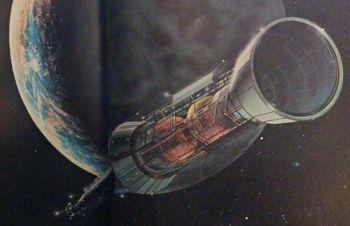Difference between revisions of "Columbus class (FASA)"
m |
m |
||
| Line 1: | Line 1: | ||
{{DISPLAYTITLE:''Columbus'' class}} | {{DISPLAYTITLE:''Columbus'' class}} | ||
[[File:columbus_class-sfc.jpg|350px|thumb|right|''Columbus'' class ([[Star Trek: Spaceflight Chronology (Book)|SFC]])]] | [[File:columbus_class-sfc.jpg|350px|thumb|right|''Columbus'' class ([[Star Trek: Spaceflight Chronology (Book)|SFC]])]] | ||
| − | The ''Columbus'' class sublight explorer—an 8,600-ton craft powered by a high-acceleration, sub-light Bussard ramjet, and housing a crew of 40—entered service in [[Chronology: | + | The ''Columbus'' class sublight explorer—an 8,600-ton craft powered by a high-acceleration, sub-light Bussard ramjet, and housing a crew of 40—entered service in [[Chronology: 2040s#2048|2048]] as [[Earth]]'s largest space-going vessels. The class boasted advanced [[impulse drive|fusion engines]] that could produce speeds of up to 0.75[[speed of light|c]] and was the first [[Humans|Human]] spacecraft class to carry on-board shuttlecraft for extra-vehicular excursions, but new ships incorporating [[Cochrane, Zefram|Zefram Cochrane]]'s [[warp drive]] engines soon superseded the class for interstellar flight, and the last ship of the class was retired in [[Chronology: 2100|2100]].<ref name="SFC"/> |
===''Columbus'' class vessels=== | ===''Columbus'' class vessels=== | ||
Revision as of 05:26, 7 May 2019

The Columbus class sublight explorer—an 8,600-ton craft powered by a high-acceleration, sub-light Bussard ramjet, and housing a crew of 40—entered service in 2048 as Earth's largest space-going vessels. The class boasted advanced fusion engines that could produce speeds of up to 0.75c and was the first Human spacecraft class to carry on-board shuttlecraft for extra-vehicular excursions, but new ships incorporating Zefram Cochrane's warp drive engines soon superseded the class for interstellar flight, and the last ship of the class was retired in 2100.[1]
Columbus class vessels
Specifications
| Length | 120m |
| Diameter | 37.2m |
| Mass | 8.6 million kg |
| Engines | Geodyne Fusion Engine pack |
| Fuel | antimatter-spiked deuterium (50:1 deuterium to antimatter) |
| Complement |
|
| Navigation | Elementary Interstellar Celestial Guidance |
| Communication | Laser/Particle Beam Subcarrier Radiotelemetry |
| Computer | Intermediate Independent Thought Memory Scan |
| Weapons |
|
| Life Support | |
| Sustenance Duration | 1-13 years at standard ship's complement |
Performance
| Range (Standard) | 5.75 billion km (Earth-Pluto) |
| Range (Maximum) | 8.5 light years |
| Velocity (Cruising) | 0.75c |
| Velocity (Maximum) | 0.85c |
| Typical Voyage Duration |
|
| Thrust | 1 billion kg |
FASA Timeline

The Columbus class sublight explorer—an 8,600-ton craft powered by a high-acceleration, sub-light Bussard ramjet, and housing a crew of 40—entered service in 2040 as Earth's largest space-going vessels. The class boasted advanced fusion engines that could produce speeds of up to 0.75c and was the first Human spacecraft class to carry on-board shuttlecraft for extra-vehicular excursions, but new ships incorporating Zefram Cochrane's warp drive engines soon superseded the class for interstellar flight, and the last ship of the class was retired in 2075.[1]
Columbus class vessels
Specifications
| Length | 120m |
| Diameter | 37.2m |
| Mass | 8.6 million kg |
| Engines | Geodyne Fusion Engine pack |
| Fuel | antimatter-spiked deuterium (50:1 deuterium to antimatter) |
| Complement |
|
| Navigation | Elementary Interstellar Celestial Guidance |
| Communication | Laser/Particle Beam Subcarrier Radiotelemetry |
| Computer | Intermediate Independent Thought Memory Scan |
| Weapons |
|
| Life Support | |
| Sustenance Duration | 1-13 years at standard ship's complement |
Performance
| Range (Standard) | 5.75 billion km (Earth-Pluto) |
| Range (Maximum) | 8.5 light years |
| Velocity (Cruising) | 0.75c |
| Velocity (Maximum) | 0.85c |
| Typical Voyage Duration |
|
| Thrust | 1 billion kg |
References
- ↑ 1.0 1.1 Goldstein, Stan and Goldstein, Fred with Sternbach, Rick. Star Trek: Spaceflight Chronology. Pocket Books, 1980.